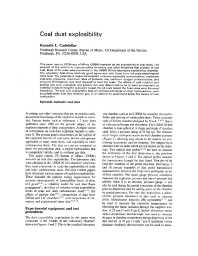Mining Publication: Coal Dust Explosibility
Original creation date: January 1996
This paper reports US Bureau of Mines (USBM) research on the explosibility of coal dusts. The purpose of this work is to improve safety in mining and other industries that process or use coal. Most of the tests were conducted in the USBM 20 litre laboratory explosibility chamber. The laboratory data show relatively good agreement with those from full-scale experimental mine tests. The parameters measured included minimum explosible concentrations, maximum explosion pressures, maximum rates of pressure rise, minimum oxygen concentrations, and amounts of limestone rock dust required to inert the coals. The effects of coal volatility and particle size were evaluated, and particle size was determined to be at least as important as volatility in determining the explosion hazard. For all coals tested, the finest sizes were the most hazardous. The coal dust explosibility data are compared to those of other hydrocarbons, such as polyethylene dust and methane gas, in an attempt to understand better the basics of coal combustion.
Authors: KL Cashdollar
Peer Reviewed Journal Article - January 1996
NIOSHTIC2 Number: 20022699
J Loss Prev Process Ind 1996 Jan 9(1):65-76
See Also
- Field Evaluation of the Coal Dust Explosibility Meter
- How Does Limestone Rock Dust Prevent Coal Dust Explosions in Coal Mines?
- How to use the Coal Dust Explosibility Meter
- Mitigating Coal Dust Explosions in Modern Underground Coal Mines
- Particle Size and Surface Area Effects on Explosibility Using a 20-L Chamber
- Recommendations for a New Rock Dusting Standard to Prevent Coal Dust Explosions in Intake Airways
- Rock Dusting
- Rock Dusting Considerations in Underground Coal Mines
- Technology for Real-Time Monitoring of Coal Dust Explosion Hazards
- Technology News 515 - Float Coal Dust Explosion Hazards
- Content source: National Institute for Occupational Safety and Health, Mining Program


 ShareCompartir
ShareCompartir
